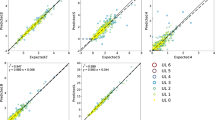Abstract
Mathematical models for predicting the transport and fate of pollutants in the environment require reactivity parameter values – that is the value of the physical and chemical constants that govern reactivity. Although empirical structure–activity relationships have been developed that allow estimation of some constants, such relationships are generally valid only within limited families of chemicals. The computer program, SPARC, uses computational algorithms based on fundamental chemical structure theory to estimate a large number of chemical reactivity parameters and physical properties for a wide range of organic molecules strictly from molecular structure. Resonance models were developed and calibrated using measured light absorption spectra, whereas electrostatic interaction models were developed using measured ionization pKas in water. Solvation models (i.e., dispersion, induction, H-bonding, etc.) have been developed using various measured physical properties data. At the present time, SPARC’s physical property models can predict vapor pressure and heat of vaporization (as a function of temperature), boiling point (as a function of pressure), diffusion coefficient (as a function of pressure and temperature), activity coefficient, solubility, partition coefficient and chromatographic retention time as a function of solvent and temperature. This prediction capability crosses chemical family boundaries to cover a broad range of organic compounds.


Similar content being viewed by others
References
Miller MM, Wasik SP, Huang GL, Shiu WT, Mackay D (1985) Environ Sci Technol 19:522
Rekker RF (1977) The hydrophobic fragment constant. Elsevier, Amsterdam
Banerjee S, Yalkowsky SH, Valvani SC (1980) Environ Sci Toxicol 14:1227
Doucette WJ, Andren AW (1987) Environ Sci Technol 21:821
Lyman WJ, Reehl E, Rosenblatt D (1990) Handbook of Chemical Property Estimation Methods. ACS (ed), Washington
Leo AJ (1975) In: Veith GD (ed) Structure activity correlations in studies of toxicity and bio-concentrations with aquatic organism. International Joint Commission, Windsor, p 151
Wolfe NL, Zepp RG, Gordon JA, Baughman GL, Cline DM (1977) Environ Sci Technol 11:88
Zepp RG, Cline DM (1977) Environ Sci Technol 11:359
Zepp RG (1982) Handbook of environmental chemistry. Springer Verlag, New York
Karickhoff SW, McDaniel VK, Melton C, Vellino AN, Nute DE, Carreira LA (1991) Environ Tox Chem 10:1405
Hilal SH, Karickhoff SW, Carreira LA (1995) Quant Struct Act Relat 14:348
Hilal SH, Karickhoff SW, Carreira LA (2003) QSAR Comb Sci 22:565
Hilal SH, Carreira LA, Karickhoff SW (2004) QSAR Comb Sci 23:709
Hilal SH, Carreira LA, Karickhoff SW, Melton CM (1993) Quant Struct Act Relat 12:389
Whiteside TS, Hilal SH, Carreira LA (2006) QSAR Comb Sci 25:123
Hilal SH, Carreira LA (2007) To be submitted
Hilal SH, Carreira LA, Karickhoff SW, Melton CM (1994) J Chromatogr 662:269
Whiteside TS, Carreira LA, Hilal SH, Brenner A (2007) To be submitted
Dykyj J, Repas M, Svoboda AJ (1984) Vapor pressure of organic substances. VEDA, Vydavatel’ stvo, Slovenskej Akademie Vied, Bratislava
Flory PJ (1941) J Chem Phys 9:660
Huggins ML (1941) J Chem Phys 9:440
Tarjan G, Timar I, Takacs JM, Meszaros SY, Nyiredy S, Budahegyl MV, Lombosi ER, Lombosi TS (1982) J Chromatogr 271:213
Haken JK, Evans MB (1989) J Chromatogr 93:472
Budavari S, O’Neil M, Smith A, Heckelman PE, Kinneary JF (1996) The Merck index. Merck & CO., Inc., Whitehouse Station
Heller SR, Bigwood DW, Laster P, Scott K, Ars pesticide properties database. USDA
Hartley D, Kidd H (1983) The agro chemical handbook. Royal Society of Chemistry, Nottingham
Yalkowsky SH, He Y (2006) AQUASOL dATAbASE of aqueous solubility. The University of Arizona
Meylan WM, Howard PH (2004) SRC’s EPI suite: PHYSPROP database. Syracuse Research Corporation
Author information
Authors and Affiliations
Corresponding author
Rights and permissions
About this article
Cite this article
Hilal, S.H., Saravanaraj, A.N., Whiteside, T. et al. Calculating physical properties of organic compounds for environmental modeling from molecular structure. J Comput Aided Mol Des 21, 693–708 (2007). https://doi.org/10.1007/s10822-007-9134-y
Received:
Accepted:
Published:
Issue Date:
DOI: https://doi.org/10.1007/s10822-007-9134-y




